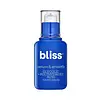What's inside
What's inside
 Key Ingredients
Key Ingredients

 Benefits
Benefits

 Concerns
Concerns

 Ingredients Side-by-side
Ingredients Side-by-side

Water
Skin ConditioningGlycolic Acid
BufferingAloe Barbadensis Leaf Juice
Skin ConditioningGlycerin
HumectantPropanediol
SolventSodium Hydroxide
BufferingPolyacrylate Crosspolymer-6
Emulsion StabilisingGluconolactone
Skin ConditioningSaccharum Officinarum Extract
MoisturisingDipropylene Glycol
HumectantTocopherol
AntioxidantPyrus Malus Fruit Extract
Skin ConditioningCitrus Aurantium Dulcis Fruit Extract
MaskingCitrus Limon Fruit Extract
MaskingCamellia Sinensis Leaf Extract
AntimicrobialGlycyrrhiza Glabra Root Extract
BleachingSqualane
EmollientSalix Nigra Bark Extract
Skin ProtectingNymphaea Alba Flower Extract
Skin ConditioningHelianthus Annuus Seed Oil
EmollientAvena Sativa Kernel Oil
Skin ConditioningSodium Palmitoyl Proline
Skin ConditioningXanthan Gum
EmulsifyingAcacia Senegal Gum
MaskingHydroxyethyl Acrylate/Sodium Acryloyldimethyl Taurate Copolymer
Emulsion StabilisingPolyglyceryl-4 Laurate/Succinate
Lauryl Glucoside
CleansingDimethicone
EmollientSodium Citrate
BufferingPhenoxyethanol
PreservativePotassium Sorbate
PreservativeSodium Benzoate
MaskingCitric Acid
BufferingParfum
MaskingWater, Glycolic Acid, Aloe Barbadensis Leaf Juice, Glycerin, Propanediol, Sodium Hydroxide, Polyacrylate Crosspolymer-6, Gluconolactone, Saccharum Officinarum Extract, Dipropylene Glycol, Tocopherol, Pyrus Malus Fruit Extract, Citrus Aurantium Dulcis Fruit Extract, Citrus Limon Fruit Extract, Camellia Sinensis Leaf Extract, Glycyrrhiza Glabra Root Extract, Squalane, Salix Nigra Bark Extract, Nymphaea Alba Flower Extract, Helianthus Annuus Seed Oil, Avena Sativa Kernel Oil, Sodium Palmitoyl Proline, Xanthan Gum, Acacia Senegal Gum, Hydroxyethyl Acrylate/Sodium Acryloyldimethyl Taurate Copolymer, Polyglyceryl-4 Laurate/Succinate, Lauryl Glucoside, Dimethicone, Sodium Citrate, Phenoxyethanol, Potassium Sorbate, Sodium Benzoate, Citric Acid, Parfum
Water
Skin ConditioningSodium C14-16 Olefin Sulfonate
CleansingCocamidopropyl Betaine
CleansingSalix Nigra Bark Extract
Skin ProtectingCocamidopropyl Hydroxysultaine
CleansingAcrylates Copolymer
Glycerin
HumectantPropanediol
SolventSalicylic Acid
MaskingSea Water
HumectantHamamelis Virginiana Leaf Extract
Skin ConditioningZinc PCA
HumectantSodium PCA
HumectantMelaleuca Alternifolia Leaf Oil
AntioxidantChamomilla Recutita Flower Extract
MaskingHydrolyzed Jojoba Esters
Skin ConditioningAnhydroxylitol
HumectantGlyceryl Oleate
EmollientXylityl Sesquicaprylate
AntimicrobialDecyl Glucoside
CleansingCoco-Glucoside
CleansingCaprylyl/Capryl Glucoside
CleansingTetrasodium Glutamate Diacetate
Phenoxyethanol
PreservativeEthylhexylglycerin
Skin ConditioningCitric Acid
BufferingSodium Hydroxide
BufferingWater, Sodium C14-16 Olefin Sulfonate, Cocamidopropyl Betaine, Salix Nigra Bark Extract, Cocamidopropyl Hydroxysultaine, Acrylates Copolymer, Glycerin, Propanediol, Salicylic Acid, Sea Water, Hamamelis Virginiana Leaf Extract, Zinc PCA, Sodium PCA, Melaleuca Alternifolia Leaf Oil, Chamomilla Recutita Flower Extract, Hydrolyzed Jojoba Esters, Anhydroxylitol, Glyceryl Oleate, Xylityl Sesquicaprylate, Decyl Glucoside, Coco-Glucoside, Caprylyl/Capryl Glucoside, Tetrasodium Glutamate Diacetate, Phenoxyethanol, Ethylhexylglycerin, Citric Acid, Sodium Hydroxide
 Reviews
Reviews

Ingredients Explained
These ingredients are found in both products.
Ingredients higher up in an ingredient list are typically present in a larger amount.
Citric Acid is an alpha hydroxy acid (AHA) naturally found in citrus fruits like oranges, lemons, and limes.
Like other AHAs, citric acid can exfoliate skin by breaking down the bonds that hold dead skin cells together. This helps reveal smoother and brighter skin underneath.
However, this exfoliating effect only happens at high concentrations (20%) which can be hard to find in cosmetic products.
Due to this, citric acid is usually included in small amounts as a pH adjuster. This helps keep products slightly more acidic and compatible with skin's natural pH.
In skincare formulas, citric acid can:
While it can provide some skin benefits, research shows lactic acid and glycolic acid are generally more effective and less irritating exfoliants.
Most citric acid used in skincare today is made by fermenting sugars (usually from molasses). This synthetic version is identical to the natural citrus form but easier to stabilize and use in formulations.
Read more about some other popular AHA's here:
Learn more about Citric AcidGlycerin is already naturally found in your skin. It helps moisturize and protect your skin.
A study from 2016 found glycerin to be more effective as a humectant than AHAs and hyaluronic acid.
As a humectant, it helps the skin stay hydrated by pulling moisture to your skin. The low molecular weight of glycerin allows it to pull moisture into the deeper layers of your skin.
Hydrated skin improves your skin barrier; Your skin barrier helps protect against irritants and bacteria.
Glycerin has also been found to have antimicrobial and antiviral properties. Due to these properties, glycerin is often used in wound and burn treatments.
In cosmetics, glycerin is usually derived from plants such as soybean or palm. However, it can also be sourced from animals, such as tallow or animal fat.
This ingredient is organic, colorless, odorless, and non-toxic.
Glycerin is the name for this ingredient in American English. British English uses Glycerol/Glycerine.
Learn more about GlycerinPhenoxyethanol is a preservative that has germicide, antimicrobial, and aromatic properties. Studies show that phenoxyethanol can prevent microbial growth. By itself, it has a scent that is similar to that of a rose.
It's often used in formulations along with Caprylyl Glycol to preserve the shelf life of products.
Propanediol is an all-star ingredient. It softens, hydrates, and smooths the skin.
It’s often used to:
Propanediol is not likely to cause sensitivity and considered safe to use. It is derived from corn or petroleum with a clear color and no scent.
Learn more about PropanediolWe don't have a description for Salix Nigra Bark Extract yet.
Sodium Hydroxide is also known as lye or caustic soda. It is used to adjust the pH of products; many ingredients require a specific pH to be effective.
In small amounts, sodium hydroxide is considered safe to use. However, large amounts may cause chemical burns due to its high alkaline.
Your skin has a natural pH and acid mantle. This acid mantle helps prevent harmful bacteria from breaking through. The acid mantle also helps keep your skin hydrated.
"Alkaline" refers to a high pH level. A low pH level would be considered acidic.
Learn more about Sodium HydroxideWater. It's the most common cosmetic ingredient of all. You'll usually see it at the top of ingredient lists, meaning that it makes up the largest part of the product.
So why is it so popular? Water most often acts as a solvent - this means that it helps dissolve other ingredients into the formulation.
You'll also recognize water as that liquid we all need to stay alive. If you see this, drink a glass of water. Stay hydrated!
Learn more about Water